2004 ISUZU TF SERIES fuel pressure
[x] Cancel search: fuel pressurePage 1556 of 4264

6E–184 4JA1/4JH1 ENGINE DRIVEABILITY AND EMISSIONS
Condition for setting the DTC and action taken when the DTC sets
Circuit description
The ECM monitors altitude from the barometric
pressure sensor. To apply specified vacuum pressure to
the turbocharger wastegate valve, ECM sends control
signal to the wastegate control solenoid depending on
altitude.
Then, apply vacuum pressure to the turbocharger
wastegate valve is monitored by the ECM form the
vacuum pressure sensor output signal. The ECM
controls wastegate control solenoid based on signal
from vacuum pressure sensor output.
If the vacuum pressure sensor detected vacuum
pressure is excessively low or high due to faulty vacuum
line, vacuum pump or turbocharger wastegate valve,
DTC P0243 (Symptom Code 3), P0243 (Symptom Code
5) or P0243 (Symptom Code 6) will be stored.
If the wastegate control solenoid circuit is open or short
to ground circuit, DTC P0243 (Symptom Code 4) will be
stored.
If the wastegate control solenoid circuit is short to
voltage circuit, DTC P0243 (Symptom Code 8) will be
stored.
Diagnostic Aids
An intermittent may be caused by the following:
Poor connections.
Misrouted harness.
Rubbed through wire insulation.
Broken wire inside insulation.
Turbocharger wastegate valve sticking or broken.
Misrouted vacuum hose.
Faulty vacuum pump or regulating valve.
Check for the following conditions:
Poor connection at ECM-Inspect harness connectors
for backed out terminals, improper mating, broken
locks, improperly formed or damaged terminals, and
poor terminal to wire connection.
Damaged harness-Inspect the wiring harness for
damage. If the harness appears to be OK, observe
the DTC P0243 display on the Tech 2 while moving
connectors and wiring harnesses. A change in the
display will indicate the location of the fault.
Flash
CodeCode Symptom
CodeMIL DTC Name DTC Setting Condition Fail-Safe (Back Up)
64 P0243 3 ON Turbocharger Wastegate
So le no id "A" Ra nge/
Pe rfo rma nce1. Intake air temperature is
between -50 deg. C and
2 0 0 d e g . C .
2. Engine coolant
temperature is between -
50 deg. C and 150 deg.
C. 1. Fuel injection quantity is
r e d u c e d .
2. EGR EVRV becomes 10%
co nditio n.
4 ON Turbocharger Wastegate
So le no id "A" Lo w Wastegate control EVRV
circuit open or short to ground
circuit.1. Fuel injection quantity is
r e d u c e d .
2. EGR EVRV becomes 10%
c o n d i t i o n .
3. Wastegate control EVRV
be co mes 32% conditio n.
5 ON Turbocharger Wastegate
So le no id "A" Ra nge/
Pe rfo rma nce1. Intake air temperature is
between -50 deg. C and
2 0 0 d e g . C .
2. Engine coolant
temperature is between -
50 deg. C and 150 deg.
C. 1. Fuel injection quantity is
r e d u c e d .
2. EGR EVRV becomes 10%
co nditio n.
6 ON Turbocharger Wastegate
So le no id "A" Malfunctio n1. Engine coolant
temperature is between -
50 deg. C and 150 deg.
C .
2. EGR contro l EVRV 0%
co nditio n.
8 ON Turbocharger Wastegate
So le no id "A" HighWastegate control EVRV
circuit short to voltage circuit.1. Fuel injection quantity is
r e d u c e d .
2. EGR EVRV becomes 10%
c o n d i t i o n .
3. Wastegate control EVRV
be co mes 32% conditio n.
Page 1569 of 4264
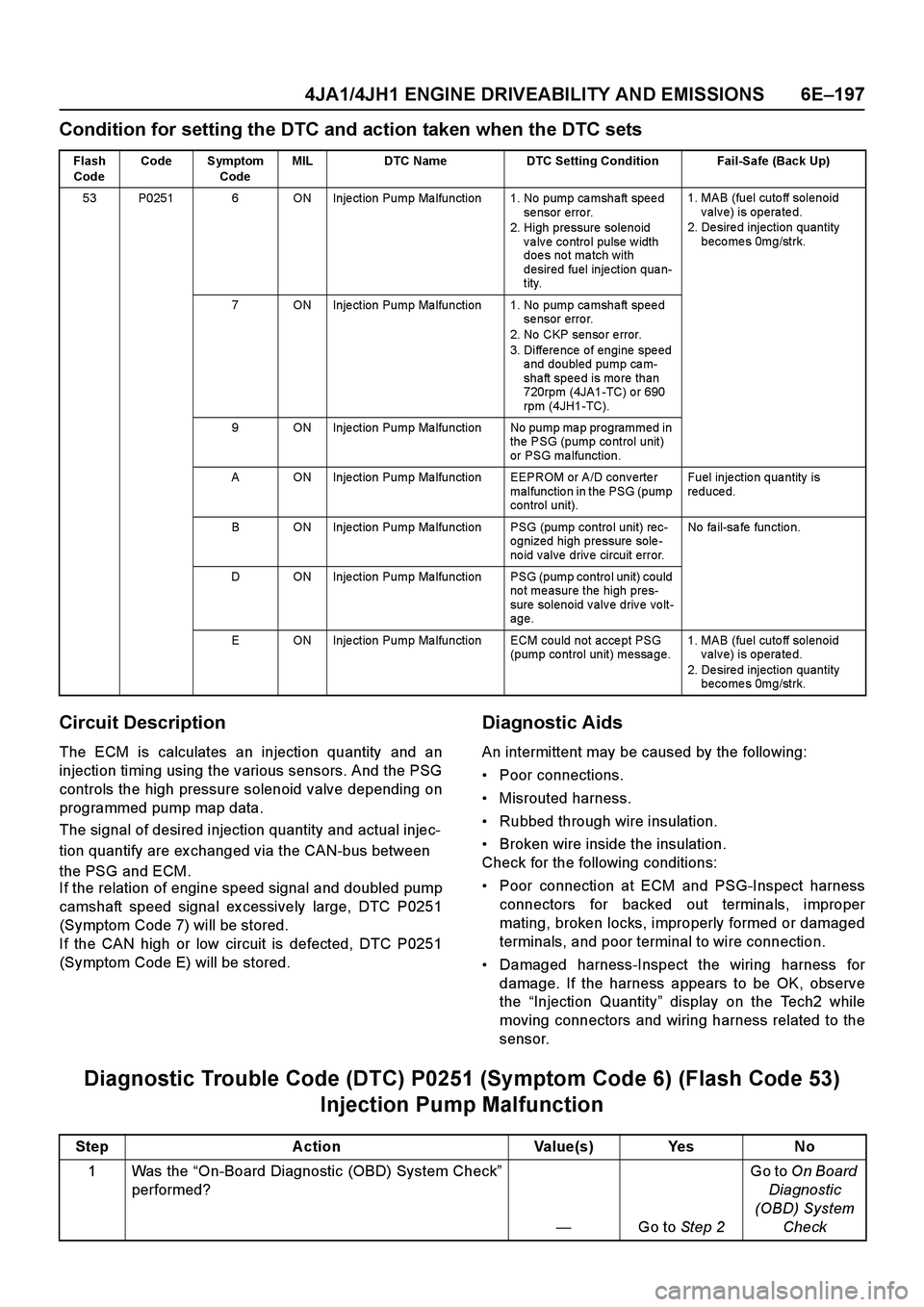
4JA1/4JH1 ENGINE DRIVEABILITY AND EMISSIONS 6E–197
Condition for setting the DTC and action taken when the DTC sets
Circuit Description
The ECM is calculates an injection quantity and an
injection timing using the various sensors. And the PSG
controls the high pressure solenoid valve depending on
programmed pump map data.
The signal of desired injection quantity and actual injec-
tion quantify are ex changed via the CAN-bus between
the PSG and ECM.
If the relation of engine speed signal and doubled pump
camshaft speed signal ex cessively large, DTC P0251
(Symptom Code 7) will be stored.
If the CAN high or low circuit is defected, DTC P0251
(Symptom Code E) will be stored.
Diagnostic Aids
An intermittent may be caused by the following:
Poor connections.
Misrouted harness.
Rubbed through wire insulation.
Broken wire inside the insulation.
Check for the following conditions:
Poor connection at ECM and PSG-Inspect harness
connectors for backed out terminals, improper
mating, broken locks, improperly formed or damaged
terminals, and poor terminal to wire connection.
Damaged harness-Inspect the wiring harness for
damage. If the harness appears to be OK, observe
the “Injection Quantity” display on the Tech2 while
moving connectors and wiring harness related to the
sensor.
Diagnostic Trouble Code (DTC) P0251 (Symptom Code 6) (Flash Code 53)
Injection Pump Malfunction
Flash
CodeCode Symptom
CodeMIL DTC Name DTC Setting Condition Fail-Safe (Back Up)
53 P0251 6 ON Injection Pump Malfunction 1. No pump camshaft speed
se nsor erro r.
2. High pressure solenoid
v a lv e co ntro l pulse w idth
doe s no t ma tch with
desired fuel injection quan-
tity. 1. MAB (fuel cutoff solenoid
valve) is operated.
2. Desired injection quantity
becomes 0mg/strk.
7 ON Injection Pump Malfunction 1. No pump camshaft speed
se nsor erro r.
2. No CKP senso r e rror.
3. Difference of engine speed
and doubled pump cam-
shaft speed is more than
720rpm (4JA1-TC) or 690
rpm (4JH1-TC).
9 ON Injection Pump Malfunction No pump map programmed in
the PSG (pump co ntrol unit)
or PSG malfunction.
A ON Injection Pump Malfunction EEPROM or A/D converter
malfunctio n in the PSG (pump
control unit).Fuel inje ctio n qua ntity is
reduced.
B ON Injection Pump Malfunction PSG (pump control unit) rec-
ognized high pressure sole -
noid valve drive circuit error.No fa il-sa fe fun ctio n.
D ON Injection Pump Malfunction PSG (pump control unit) could
no t me asure the high pres-
sure solenoid valve drive volt-
age.
E ON Injection Pump Malfunction ECM could not accept PSG
(pump co ntrol unit) messa ge.1. MAB (fuel cutoff solenoid
valve) is operated.
2. Desired injection quantity
becomes 0mg/strk.
Step Action Value(s) Yes No
1Was the “On-Board Diagnostic (OBD) System Check”
performed?
—Go to Step 2Go to On Board
Diagnostic
(OBD) System
Check
Page 1712 of 4264
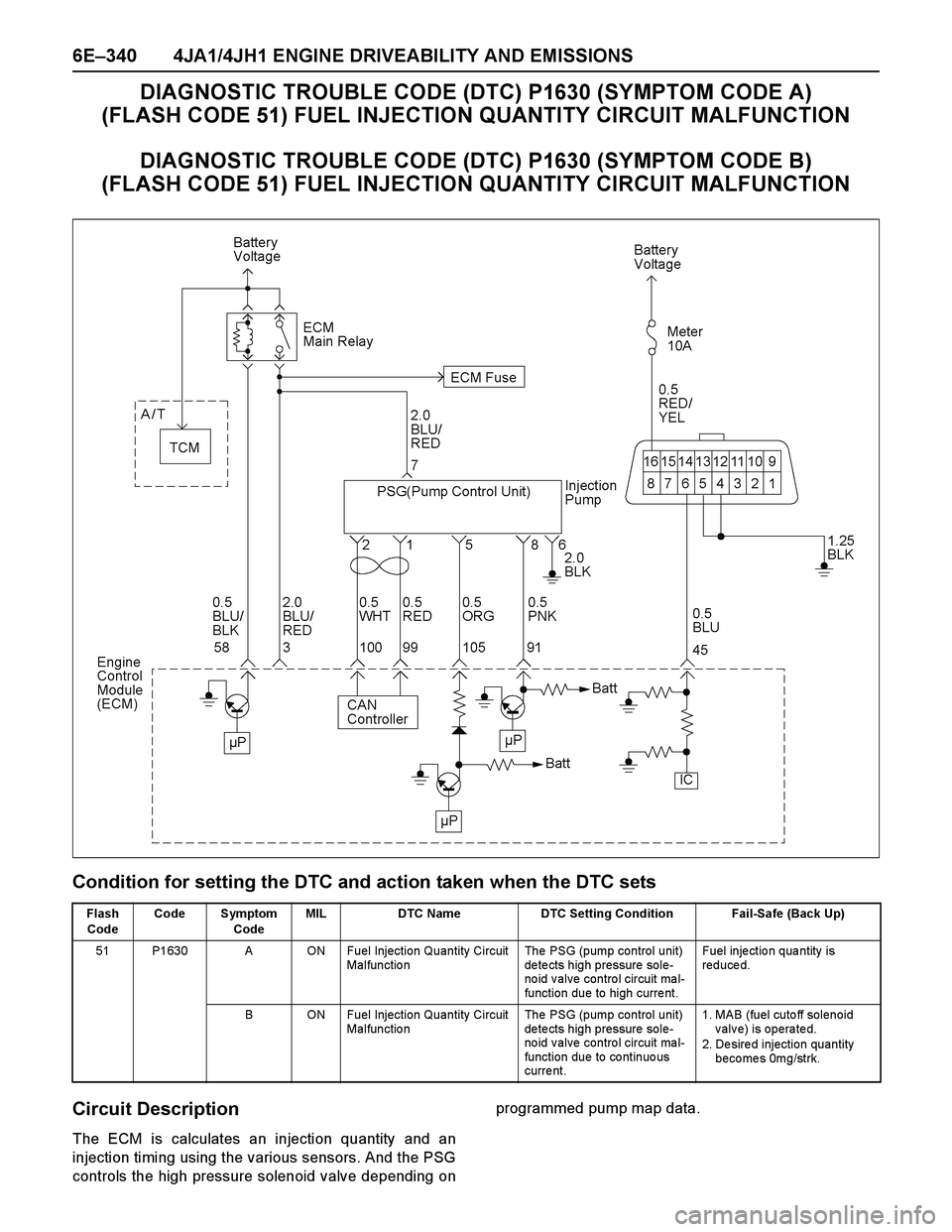
6E–340 4JA1/4JH1 ENGINE DRIVEABILITY AND EMISSIONS
DIAGNOSTIC TROUBLE CODE (DTC) P1630 (SYMPTOM CODE A)
(FLASH CODE 51) FUEL INJECTION QUANTITY CIRCUIT MALFUNCTION
DIAGNOSTIC TROUBLE CODE (DTC) P1630 (SYMPTOM CODE B)
(FLASH CODE 51) FUEL INJECTION QUANTITY CIRCUIT MALFUNCTION
Condition for setting the DTC and action taken when the DTC sets
Circuit Description
The ECM is calculates an injection quantity and an
injection timing using the various sensors. And the PSG
controls the high pressure solenoid valve depending onprogrammed pump map data.
Flash
CodeCode Symptom
CodeMIL DTC Name DTC Setting Condition Fail-Safe (Back Up)
51 P1630 A ON Fuel Injection Quantity Circuit
Malfunctio nThe PSG (pump control unit)
de te cts high pressure sole-
no id v alve contro l circuit ma l-
function due to high curre nt.Fuel inje ctio n qua ntity is
reduced.
B ON Fuel Injection Quantity Circuit
Malfunctio nThe PSG (pump control unit)
de te cts high pressure sole-
no id v alve contro l circuit ma l-
function due to co ntinuo us
curre nt.1. MAB (fuel cutoff solenoid
valve) is operated.
2. Desired injection quantity
becomes 0mg/strk.
Page 1736 of 4264
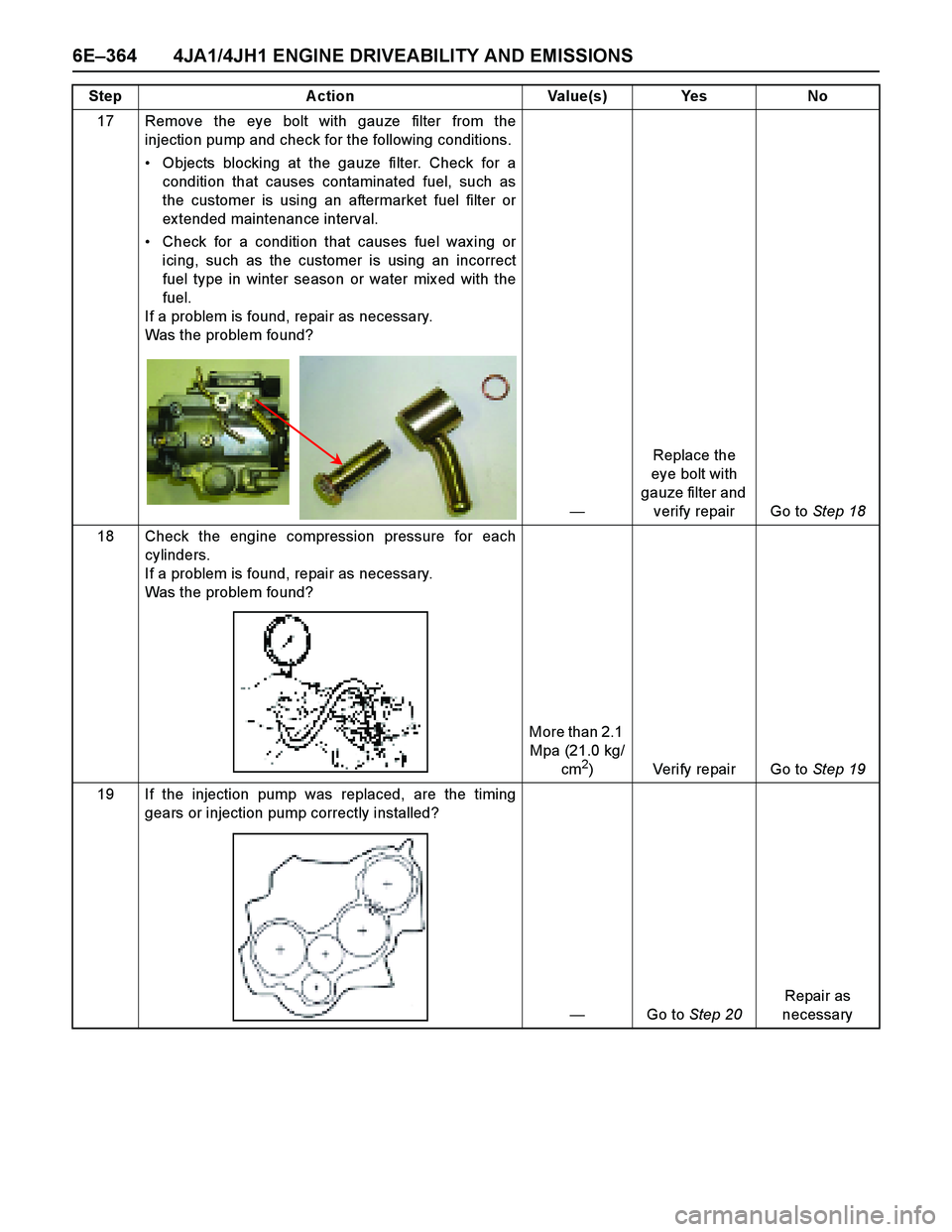
6E–364 4JA1/4JH1 ENGINE DRIVEABILITY AND EMISSIONS
17 Remove the eye bolt with gauze filter from the
injection pump and check for the following conditions.
Objects blocking at the gauze filter. Check for a
condition that causes contaminated fuel, such as
the customer is using an aftermarket fuel filter or
ex tended maintenance interval.
Check for a condition that causes fuel wax ing or
icing, such as the customer is using an incorrect
fuel type in winter season or water mix ed with the
fuel.
If a problem is found, repair as necessary.
Was the problem found?
—Replace the
eye bolt with
gauze filter and
verify repair Go to Step 18
18 Check the engine compression pressure for each
cylinders.
If a problem is found, repair as necessary.
Was the problem found?
More than 2.1
Mpa (21.0 kg/
cm
2) Verify repair Go to Step 19
19 If the injection pump was replaced, are the timing
gears or injection pump correctly installed?
—Go to Step 20Repair as
necessary Step Action Value(s) Yes No
Page 1740 of 4264
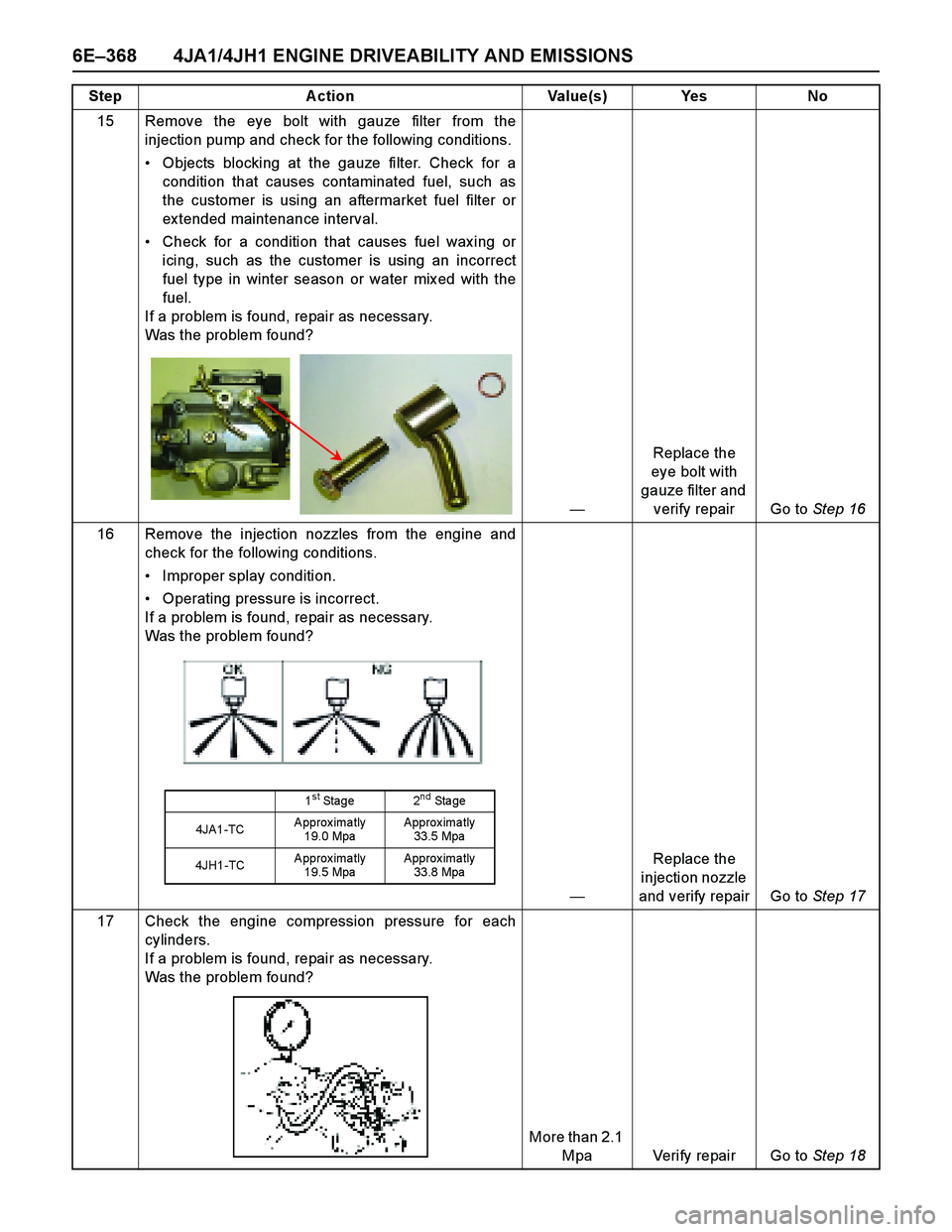
6E–368 4JA1/4JH1 ENGINE DRIVEABILITY AND EMISSIONS
15 Remove the eye bolt with gauze filter from the
injection pump and check for the following conditions.
Objects blocking at the gauze filter. Check for a
condition that causes contaminated fuel, such as
the customer is using an aftermarket fuel filter or
ex tended maintenance interval.
Check for a condition that causes fuel wax ing or
icing, such as the customer is using an incorrect
fuel type in winter season or water mix ed with the
fuel.
If a problem is found, repair as necessary.
Was the problem found?
—Replace the
eye bolt with
gauze filter and
verify repair Go to Step 16
16 Remove the injection nozzles from the engine and
check for the following conditions.
Improper splay condition.
Operating pressure is incorrect.
If a problem is found, repair as necessary.
Was the problem found?
—Replace the
injection nozzle
and verify repair Go to Step 17
17 Check the engine compression pressure for each
cylinders.
If a problem is found, repair as necessary.
Was the problem found?
More than 2.1
Mpa Verify repair Go to Step 18 Step Action Value(s) Yes No
1st Stage 2nd Sta ge
4JA1-TCApproximatly
19.0 MpaApprox ima tly
33.5 Mpa
4JH1-TCApproximatly
19.5 MpaApprox ima tly
33.8 Mpa
Page 1746 of 4264
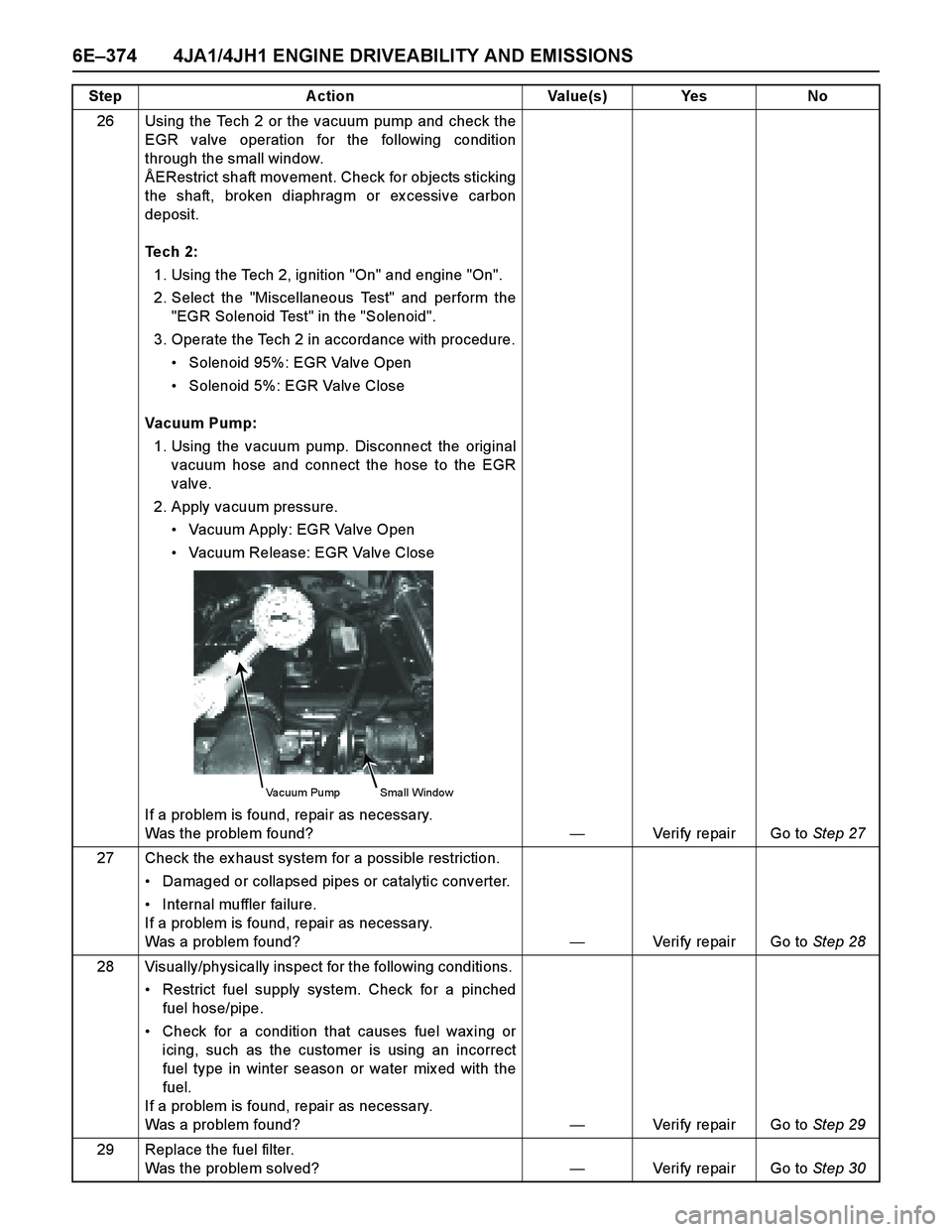
6E–374 4JA1/4JH1 ENGINE DRIVEABILITY AND EMISSIONS
26 Using the Tech 2 or the vacuum pump and check the
EGR valve operation for the following condition
through the small window.
ÅERestrict shaft movement. Check for objects sticking
the shaft, broken diaphragm or ex cessive carbon
deposit.
Tech 2:
1. Using the Tech 2, ignition "On" and engine "On".
2. Select the "Miscellaneous Test" and perform the
"EGR Solenoid Test" in the "Solenoid".
3. Operate the Tech 2 in accordance with procedure.
Solenoid 95%: EGR Valve Open
Solenoid 5%: EGR Valve Close
Vacuum Pump:
1. Using the vacuum pump. Disconnect the original
vacuum hose and connect the hose to the EGR
valve.
2. Apply vacuum pressure.
Vacuum Apply: EGR Valve Open
Vacuum Release: EGR Valve Close
If a problem is found, repair as necessary.
Was the problem found?—Verify repair Go to Step 27
27 Check the ex haust system for a possible restriction.
Damaged or collapsed pipes or catalytic converter.
Internal muffler failure.
If a problem is found, repair as necessary.
Was a problem found?—Verify repair Go to Step 28
28 Visually/physically inspect for the following conditions.
Restrict fuel supply system. Check for a pinched
fuel hose/pipe.
Check for a condition that causes fuel wax ing or
icing, such as the customer is using an incorrect
fuel type in winter season or water mix ed with the
fuel.
If a problem is found, repair as necessary.
Was a problem found?—Verify repair Go to Step 29
29 Replace the fuel filter.
Was the problem solved?—Verify repair Go to Step 30 Step Action Value(s) Yes No
Vacuum Pump Small Window
Page 1747 of 4264
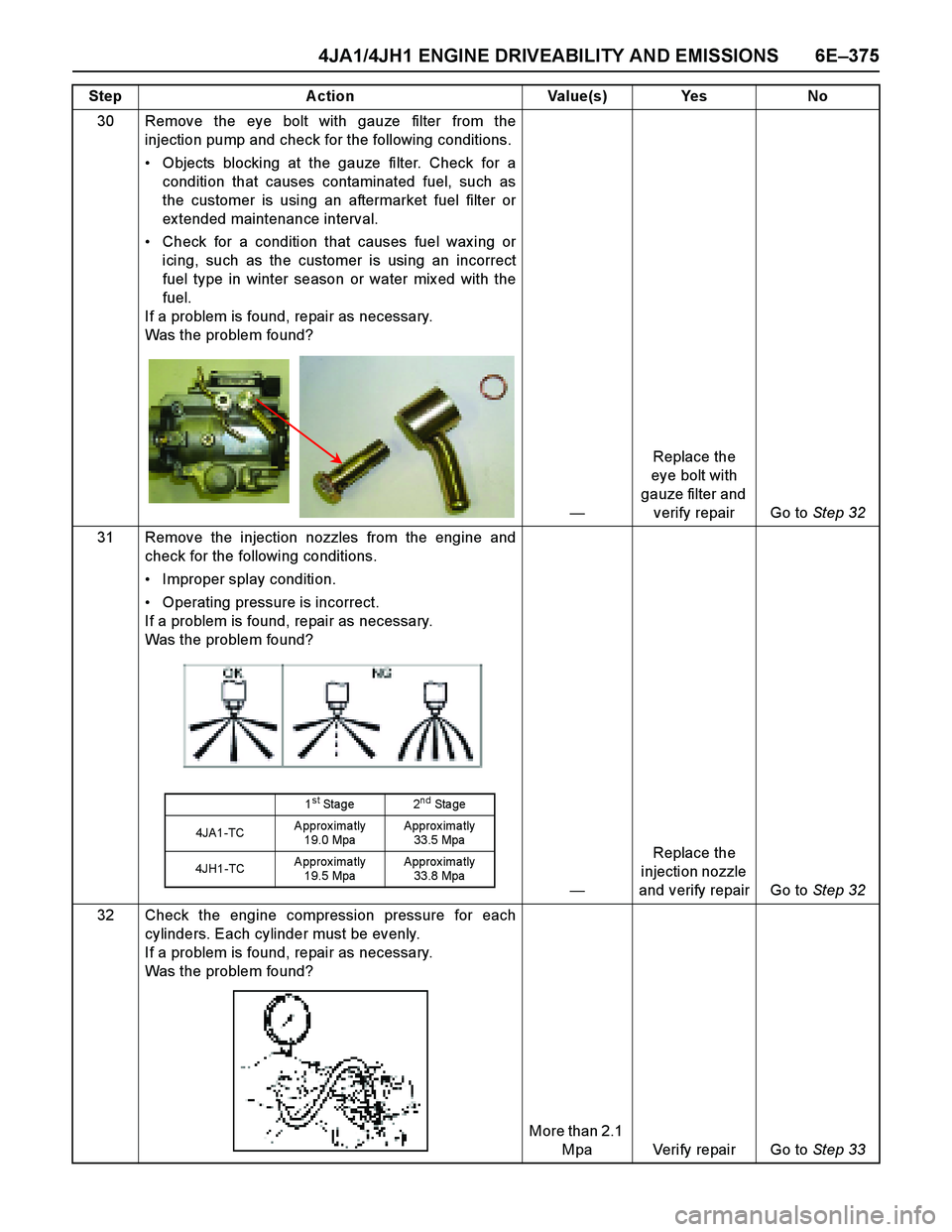
4JA1/4JH1 ENGINE DRIVEABILITY AND EMISSIONS 6E–375
30 Remove the eye bolt with gauze filter from the
injection pump and check for the following conditions.
Objects blocking at the gauze filter. Check for a
condition that causes contaminated fuel, such as
the customer is using an aftermarket fuel filter or
ex tended maintenance interval.
Check for a condition that causes fuel wax ing or
icing, such as the customer is using an incorrect
fuel type in winter season or water mix ed with the
fuel.
If a problem is found, repair as necessary.
Was the problem found?
—Replace the
eye bolt with
gauze filter and
verify repair Go to Step 32
31 Remove the injection nozzles from the engine and
check for the following conditions.
Improper splay condition.
Operating pressure is incorrect.
If a problem is found, repair as necessary.
Was the problem found?
—Replace the
injection nozzle
and verify repair Go to Step 32
32 Check the engine compression pressure for each
cylinders. Each cylinder must be evenly.
If a problem is found, repair as necessary.
Was the problem found?
More than 2.1
Mpa Verify repair Go to Step 33 Step Action Value(s) Yes No
1st Stage 2nd Sta ge
4JA1-TCApproximatly
19.0 MpaApprox ima tly
33.5 Mpa
4JH1-TCApproximatly
19.5 MpaApprox ima tly
33.8 Mpa
Page 1752 of 4264
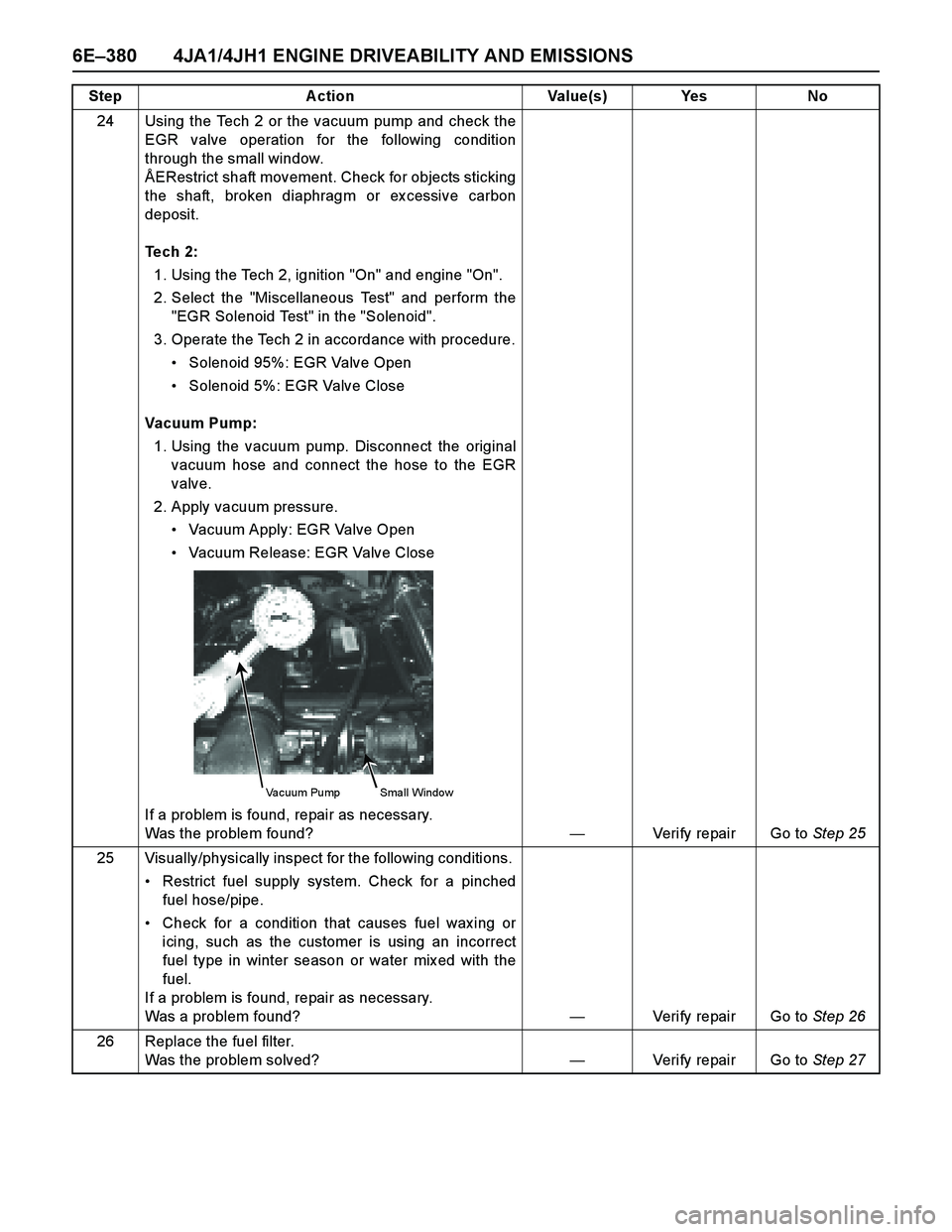
6E–380 4JA1/4JH1 ENGINE DRIVEABILITY AND EMISSIONS
24 Using the Tech 2 or the vacuum pump and check the
EGR valve operation for the following condition
through the small window.
ÅERestrict shaft movement. Check for objects sticking
the shaft, broken diaphragm or ex cessive carbon
deposit.
Tech 2:
1. Using the Tech 2, ignition "On" and engine "On".
2. Select the "Miscellaneous Test" and perform the
"EGR Solenoid Test" in the "Solenoid".
3. Operate the Tech 2 in accordance with procedure.
Solenoid 95%: EGR Valve Open
Solenoid 5%: EGR Valve Close
Vacuum Pump:
1. Using the vacuum pump. Disconnect the original
vacuum hose and connect the hose to the EGR
valve.
2. Apply vacuum pressure.
Vacuum Apply: EGR Valve Open
Vacuum Release: EGR Valve Close
If a problem is found, repair as necessary.
Was the problem found?—Verify repair Go to Step 25
25 Visually/physically inspect for the following conditions.
Restrict fuel supply system. Check for a pinched
fuel hose/pipe.
Check for a condition that causes fuel wax ing or
icing, such as the customer is using an incorrect
fuel type in winter season or water mix ed with the
fuel.
If a problem is found, repair as necessary.
Was a problem found?—Verify repair Go to Step 26
26 Replace the fuel filter.
Was the problem solved?—Verify repair Go to Step 27 Step Action Value(s) Yes No
Vacuum Pump Small Window